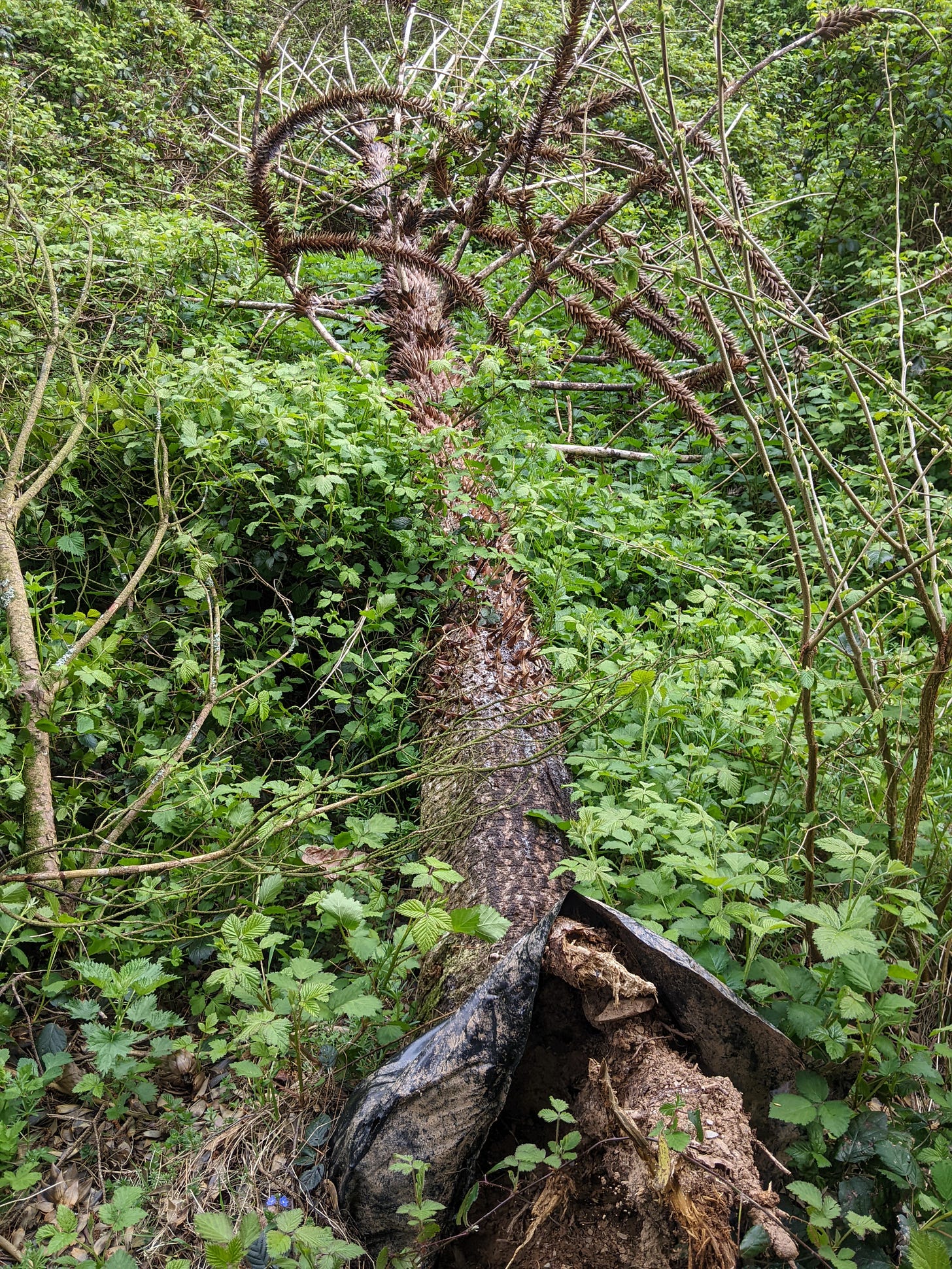Apologies for a bit of a lull here since the Forest Garden situation blew up. That was a highly distracting diversion from playing with and writing about plants to which I have returned. (Meanwhile see https://www.agroforestry.co.uk/save-dartington-forest-garden for latest update on the FG)
We have a second site on the Dartington Estate - apart from the forest garden we have a trials site which is dominated by nut trees. We’ve had this site 28 years and as well as the common nut trees (walnuts, hazels, sweet chestnuts) we have heartnuts, butternuts, black walnuts, hickories, pecans, chinkapins, pine nuts and monkey puzzle/chile pine trees. As you’d expect, autumn is busy on this site and in spring there isn’t too much work to do after the brambling season has finished.
I was walking around this site last week and came across this:
Yes, it’s a dead money puzzle (Araucaria) tree which has toppled a year or so after the leaves turned brown.
One of the facts about experimenting is that sometimes you fail, and the Araucarias have made that clear. I planted 7 trees here some 24 years ago. Because monkey puzzle is dioecious (with male and female flowers on different trees) it is essential to plant a group to be able to get nuts. Even with 7 trees there was a 1/64 chance that they would be all male or all female and be useless from the nut production point of view, but that seemed a small enough risk to take.
They grew well (that’s my way of covering the intervening years) and the first started flowering after 19 years. Fantastic, it turned out there were males and females present. But just as they started to crop - the nuts are borne in football-sized cones, each holding several hundred pointed nuts - the trees started to die. One by one they turned brown and perished. I have not found the cause but it is obviously some soil-borne disease, maybe a Phytophthora fungus as the damage started after a series of extra wet winters; the trees are on a sloping site in a clay loam soil normally pretty well drained. But climate change is making our winters here wetter and this probably contributed to the damage.
The crops we did get were used fresh (cooked rather like chestnuts) and also dried to make Araucaria flour which is rather delicious.
There are two trees left standing (a male and a female) but one is already turning brown so they will be doomed and it is unlikely we’ll get another crop from them. I don’t regret planting them, it’s just one of those things. When they are gone it will give two stone pine trees (Pinus pinea) more space to thrive.
Meanwhile on another site we have a forest garden greenhouse. This was constructed using many of the ideas pioneered by Jerome Osentowski in Colorado, particularly the heat storage system. This uses fans and a series of underground air pipes to store heat in the soil from spring to autumn, then release the heat in winter to keep the whole place frost free. It works pretty well and although it has been down below zero (C) sometimes, it hosts a subtropical forest garden which lifts our spirits when the cloud and rain stop us from seeing the sun for days or weeks on end.
Some of the tree-sized plants we grow in there include avocados, bananas, custard apples, papaya relatives, jelly palm, strawberry guava, pomegranate ad lots of Citrus - satsuma, clementine, mandarin, lemon, thai lime.
Last autumn we spotted a banana flower on our Blue Java banana. Excitement was tempered by the fact that the flower would have to go through winter and near-zero temperatures to be able to continue flowering and fruting this year. Luckily, it did, and not only that but a second flower has formed on the same banana clump:
So in 4-5 months we should have bananas to eat - experiment permitting. And for the first year there are custard apples on the tree …… just waiting for the avocados now.




Sorry to hear of the losses. It could possibly do with more study on whether drainage or rainfall caused the losses. Here's winter rainfall since 1964-65 (meteorological winter = 1st Dec to 28th Feb) in Yeovilton (the nearest official site to Dartington);
https://www.metoffice.gov.uk/pub/data/weather/uk/climate/stationdata/yeoviltondata.txt
There are some fine established monkey puzzle trees at the south end of the Isle of Skye. It gets a little more rain than Dartington.
Great to read your progress, some slower than others, and to read I’m not alone with my losses. Natural springs popping up all over my 1 acre FG, and horsetail and creeping buttercup scuppering my ground cover crops. Nonetheless it’s a great place to hang out and have the odd nibble as I go. Thanks for all your support/training and many of my plants!